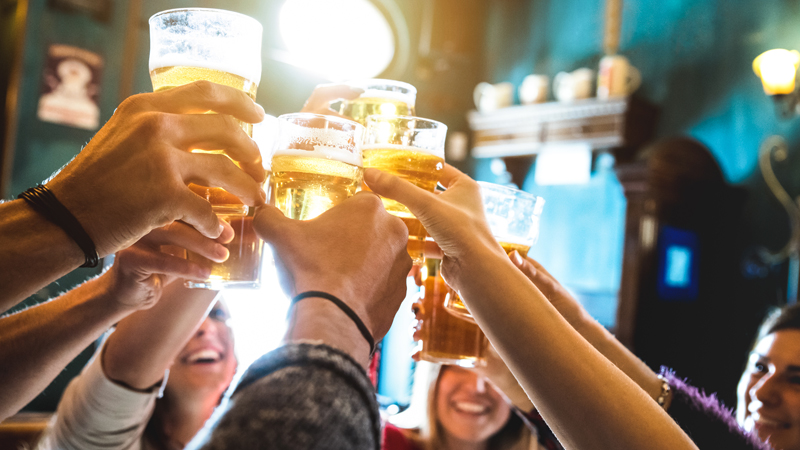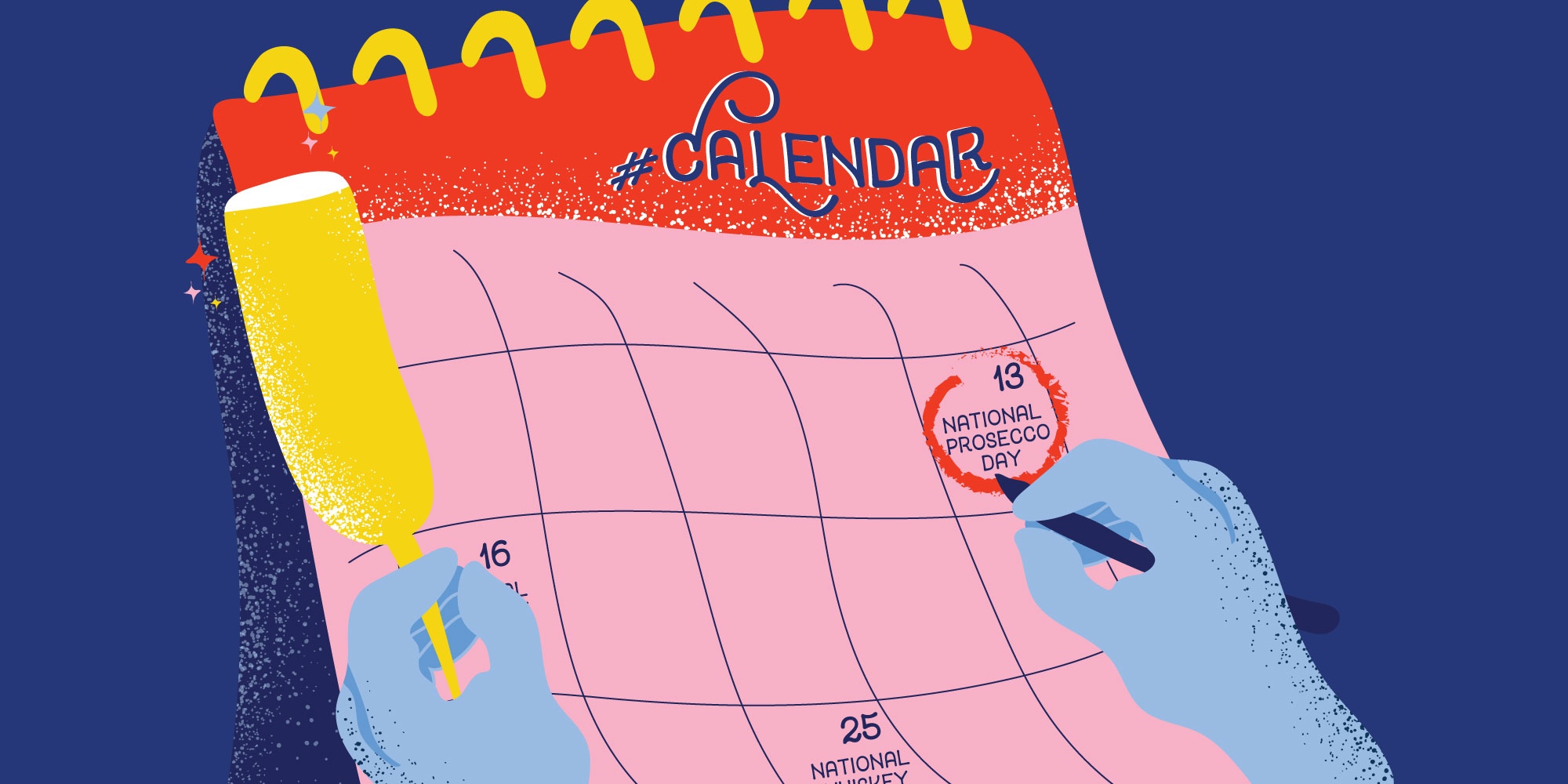Every day is either a gift or a curse, depending on your internet diet.
According to certain corners of the web, Oct. 16, the day this story first published, marks National Liqueur Day. Confusingly, Oct. 16 also falls within National Collegiate Alcohol Awareness Week.
It’s an awkward coincidence. The strange world of national days — those digital demarcations familiar to anyone who has ever used or hashtagged the phrase “TacoTuesday” — is rich with intrigue.
There are around 1,500 national days actively observed in the United States. That’s about four per day. Of those, at least 31 celebrate alcohol and the act of drinking. Their subjects range from National Wine Day (May 25) to National Moscato Day (May 9) and National Beer Can Appreciation Day (Jan. 24).
For those with an active social media account, national days are nothing new. How many of us have shamelessly snapped a picture-perfect crimson cocktail during #NegroniWeek, for example, a holiday created by Campari and Imbibe Magazine in 2013.
The fact that corporations use national days to promote products is plain to see. What’s surprising, however, is that there are entire companies dedicated to designating and selling new national days. In 2018, hashtags are big business, and, in one way or another, nearly everyone’s buying.
Where Hashtag Holidays Come From
In January 2013, web developer Marlo Anderson of North Dakota founded the National Day Calendar. A self-professed lover of national days, Anderson started the calendar as a hobby. He aimed to create the “Wikipedia” of pre-existing national days, listing everything from the date of an event to the history behind it.
Like Wikipedia, Anderson’s model allows any user to suggest adding new events to the calendar. In a stroke of genius, Anderson also offers individuals and companies the opportunity to pitch and create their own national days.
National Day Calendar’s four-person panel must unanimously approve an application for a new celebration. Anderson himself isn’t a member of this panel, but says National Day Calendar receives more than 20,000 applications annually. It typically adds between 20 and 30 new days every year.
When National Day Calendar started adding hashtags like #NationalDonutDay, it noticed that people were sharing photos and social media posts with the tags, bringing even more exposure to national days. “Almost every day there are one or two hashtags relating to a national day,” Anderson says. “Last year, I think it was 457 times that we trended number one.”
But the main reason for National Day Calendar’s success, he says, is that they are the go-to reference for information on national days, with over 20,000 media outlets subscribing to the calendar free of charge. Securing an event on the National Day Calendar almost guarantees exposure. And that exposure has a hefty price tag.
How Hashtag Holidays Work
When the National Day Calendar accepts an application, the applicant must pay a fee for the day to become official. This price ranges from a few thousand dollars for independent non-profit organizations, to tens of thousands for large corporations.
Inclusion is not auctioned off to the high bidder. Having the financial might of a spirits brand like Seagram’s 7 (founder of National Dive Bar Day, July 7) doesn’t put you in any stronger a position than a craft brewery like Traveler Beer Company (founder of National Refreshment Day, observed annually on the fourth Thursday in July). Instead, it’s all about relevance.
In 2016, National Day Calendar approved Riondo Prosecco’s application for National Prosecco Day (Aug. 13). Terlato Wines, which markets the Riondo brand in the U.S., worked with Chicago-based RPM Advertising to submit the application to National Day Calendar. The aim, says Terlato’s COO and president David Lane, was to continue the growth of Prosecco’s popularity and keep it “trending.” (In 2016, the United States was the second-largest export market for Prosecco in the world.)
Since the creation of National Prosecco Day, Riondo has been featured on the “Today” show. More than 6,500 people have used the hashtag on Instagram since 2016. Though it’s difficult to quantify the effect the national day has had on sales, “Riondo is now the fastest growing Prosecco brand in the United States,” Lane says.
Consumers have taken to National Prosecco Day, he says, not only because they enjoy the drink, but because the celebration takes place at a time of year that feels right. On Aug. 13, many drinkers are already likely to be enjoying the refreshing fizzy wine.
“It’s a great example of one of the new ways that consumers and brands are connecting,” Lane says.

Friendly Competition
National Today is another aggregator of national days. Like National Day Calendar, it presents celebratory dates in a user-friendly online calendar alongside stats, infographics, and suggestions on how to celebrate things like National Beer Can Appreciation Day. Unlike National Day Calendar, however, National Today is also a PR company that works with brands to incorporate national days into campaign planning.
Ben Kaplan, CEO and publisher of National Today, was working in public relations when he founded National Today in 2016. Kaplan’s other firm, PR Hacker, shares its contact list and data research resources with National Today. The two companies collaborate and use national day celebrations to secure media coverage for their clients.
In 2016, they worked with Budweiser to create a campaign for National Drink Beer Day. Based on research that suggested that people who drink Bud are seen as more open and friendly, National Today carried out a survey to provide statistical data to back up the claim.
According to the survey results, “Seven out of ten people say that a woman drinking a domestic beer like Budweiser is more approachable, while six out of ten say the same for men.”
What was more important than the survey itself, however, was the media coverage it generated for the brand. National and regional newspapers picked up the story, running headlines such as “Budweiser Drinkers ‘More Approachable’ Than Wine Lovers.”
For Budweiser, Kaplan says, the payoff was equivalent to a Super Bowl ad, “even though there was no paid ad spend at all.”
Spreading the Word
For corporations and savvy PR professionals, national days are, of course, a new form of consumer marketing. But not everyone campaigning to create a national day is in it for financial gain.
On a warm October evening in New York City, I joined a group of 10 people eager to celebrate one of the newest additions to the National Day Calendar. Organized by the day’s founder, New Jersey-based nurse Amanda Claire Goodwin, the group included Goodwin’s mother, cousin, and boyfriend, as well as a small handful of wine influencers and industry professionals. They had gathered to celebrate the inaugural National Orange Wine Day (Oct. 6).
Goodwin applied to create National Orange Wine Day after trying and failing to locate orange wines at many local New Jersey liquor stores.
“I said to myself, ‘They have a national day for just about everything, why doesn’t orange wine have its own day?’” Goodwin says.
During the event, Goodwin led a tasting of a few of her favorite bottles. She is not a sommelier or wine professional, but she is passionate about wine and blogs about it in her spare time under the handle, The Real Housewine. She read from a printed slideshow, discussing why more people should be drinking more orange wine and her motivation for creating the day. Part of the process, Goodwin told me later, included paying a $3,600 application fee to National Day Calendar, which she funded out of her own pocket.
With the foundation of National Orange Wine Day, Goodwin hopes to spread the word about the style so that it can become a regular fixture on wine store shelves throughout the country.
“If I can get someone in a small town in the Midwest drinking orange wine, I’ve done my job,” she says.
Connecting People
National days are inherently manufactured, a result of clever marketing, concerted individual effort, or some combination of the two. But, in essence, they’re no different from greeting card holidays like Valentine’s Day. Yes, they prompt us to spend money, but many enjoy these celebrations and they bring people together. “We need more reasons to be connected,” Kaplan says.
There are valid reasons to be cynical, but those like Goodwin prove that founding a national day can be an innocent — if costly — way of sharing your interests with friends, family, and strangers.
“Some girls buy a Chanel purse,” Goodwin says, “I bought a national day.”
